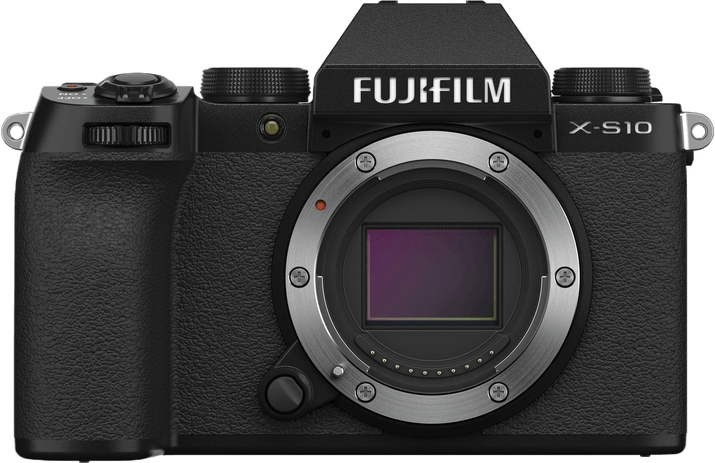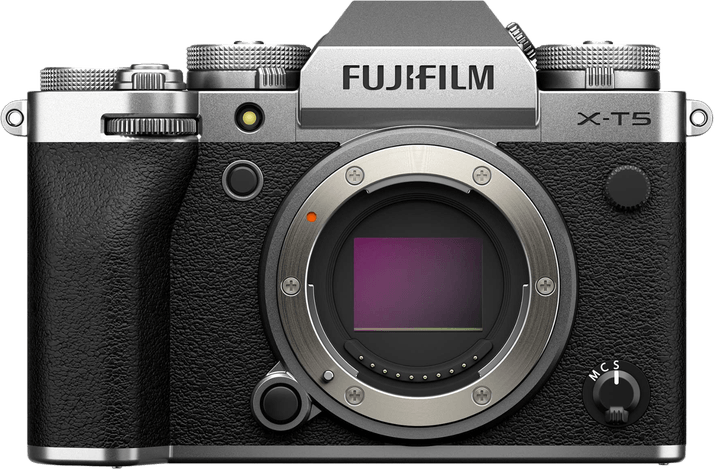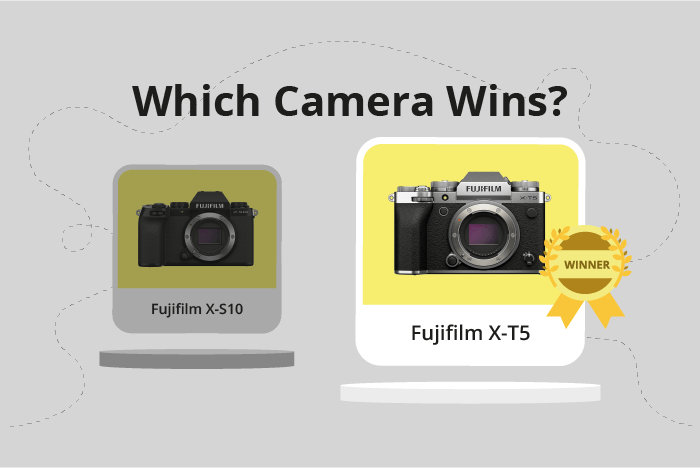Fujifilm X-S10 vs X-T5 Comparison
Fujifilm X-S10

Fujifilm X-T5

The Fujifilm X-T5 takes the lead with a score of 81/100, while the Fujifilm X-S10 trails behind with 69/100. Both cameras are mirrorless and share common features such as release year and camera type. The X-T5, being the winner, has advantages in terms of its announcement date (02/11/2022) and launch price ($1699), indicating it is a newer and more premium model.
However, the Fujifilm X-S10 has its own merits, being lighter (465g) and more compact (126 x 85 x 65mm) than the X-T5 (557g, 130 x 91 x 64mm). This makes the X-S10 a more portable option for photographers. Despite the differences, both cameras offer great value and cater to different user preferences. The X-T5 stands out as the higher-performing camera, while the X-S10 offers portability and affordability at a lower price point of $999.
Fujifilm X-S10 vs X-T5 Overview and Optics
The Fujifilm X-T5 triumphs over the Fujifilm X-S10 in terms of optics, with a score of 81/100 compared to the X-S10’s 72/100. Both cameras share several specifications, including a CMOS sensor, APS-C sensor size, Fujifilm X lens mount, and image stabilization. Despite these similarities, the X-T5’s higher score reflects its superior performance in certain areas.
The Fujifilm X-T5 has a remarkable 40-megapixel sensor, significantly more than the X-S10’s 26-megapixel offering. This higher resolution allows for greater detail and clarity in images. Furthermore, the X-T5 is equipped with the advanced X-Processor 5, while the X-S10 uses the older X-Processor 4. This newer processor improves overall image quality, speed, and performance.
On the other hand, the Fujifilm X-S10 boasts a faster shooting speed of 20 frames per second (fps), compared to the X-T5’s 15 fps. This advantage makes the X-S10 more suitable for capturing fast-moving subjects or action photography. However, this single advantage is not enough to outweigh the X-T5’s superior specifications in other areas.
In terms of optics, the Fujifilm X-T5 stands out as the clear winner due to its higher resolution and more advanced processor. These features contribute to the camera’s enhanced image quality, making it a better choice for photographers seeking exceptional detail and clarity. While the X-S10’s faster shooting speed provides an advantage in specific situations, the X-T5’s overall superiority in optics makes it the preferred choice for most users.
Fujifilm X-S10 vs X-T5 Video Performance
The Fujifilm X-S10 emerges as the winner in video capabilities with a score of 91/100, while the Fujifilm X-T5 trails close behind with a score of 87/100. Both cameras share some common video specifications, such as having built-in time-lapse functionality and offering high-resolution video recording.
The Fujifilm X-S10 outperforms the X-T5 in terms of maximum video frame rate, as it can record at an impressive 240fps, while the X-T5 has a maximum frame rate of 60fps. This higher frame rate allows the X-S10 to capture smoother and more detailed slow-motion footage, making it a better choice for videographers who prioritize this feature.
On the other hand, the Fujifilm X-T5 has a higher maximum video resolution of 6K and larger video dimensions of 6240×4160, compared to the X-S10’s 4K resolution and 4096×2160 video dimensions. This means that the X-T5 can capture more detailed and higher-resolution footage, which could be an advantage for those who want to produce content in 6K resolution.
However, it is important to note that the difference in video capabilities between the two cameras is not vast, as both offer excellent video performance. The Fujifilm X-S10’s higher score is primarily due to its superior maximum video frame rate, making it an ideal choice for slow-motion enthusiasts. Meanwhile, the Fujifilm X-T5’s higher resolution may appeal to those who prioritize capturing footage in 6K. Ultimately, the choice between these two cameras will depend on the specific video requirements and preferences of the user.
Fujifilm X-S10 vs X-T5 Features and Benefits
The Fujifilm X-T5 emerges as the winner in the features comparison, scoring 85 out of 100, while the Fujifilm X-S10 scores 70 out of 100. Both cameras share some common specifications, such as a 3-inch screen size, touchscreen capabilities, flip screen, and Bluetooth connectivity. Neither camera offers GPS functionality.
The Fujifilm X-T5 surpasses the X-S10 in screen resolution, boasting 1,840,000 dots compared to the X-S10’s 1,040,000 dots. This higher resolution provides a sharper and clearer display, enhancing the user experience. Additionally, the X-T5 offers Wi-Fi connectivity, a feature absent in the X-S10. This allows users to transfer files and control the camera remotely, increasing convenience and versatility.
The Fujifilm X-S10, despite scoring lower in features, still offers advantages in certain aspects. It shares the same touchscreen and flip screen functions as the X-T5, providing similar ease of use and flexibility for various shooting angles. The X-S10 also has Bluetooth connectivity, allowing for wireless communication with other devices.
Considering these points, the Fujifilm X-T5 outperforms the X-S10 in terms of features, primarily due to its higher screen resolution and Wi-Fi connectivity. However, the X-S10 remains a viable option for users who prioritize shared touchscreen and flip screen capabilities, along with Bluetooth connectivity. Ultimately, the decision between these two cameras depends on individual preferences and priorities.
Fujifilm X-S10 vs X-T5 Storage and Battery
The Fujifilm X-T5 outperforms the Fujifilm X-S10 in storage and battery with a score of 76/100, while the X-S10 scores 35/100. Both cameras accept SD, SDHC, and SDXC (UHS-I compatible) memory cards and support USB charging. However, the X-T5 surpasses the X-S10 in two key aspects.
Firstly, the X-T5 provides more storage flexibility with two memory card slots, compared to the X-S10’s single slot. This allows users to manage their files more efficiently and ensures they have additional storage when needed. Secondly, the X-T5 boasts a significantly longer battery life, offering 580 shots per charge with its NP-W235 battery, while the X-S10 manages 325 shots using the NP-126S battery.
The X-S10 does not have any advantages over the X-T5 in terms of storage and battery. Consequently, the Fujifilm X-T5 is the superior choice for those prioritizing storage capacity and battery longevity. The dual memory card slots and extended battery life make it a more reliable and convenient option for both professional and casual photographers.
Fujifilm X-S10 vs X-T5 – Our Verdict
Are you still undecided about which camera is right for you? Have a look at these popular comparisons that feature the Fujifilm X-S10 or the Fujifilm X-T5:

